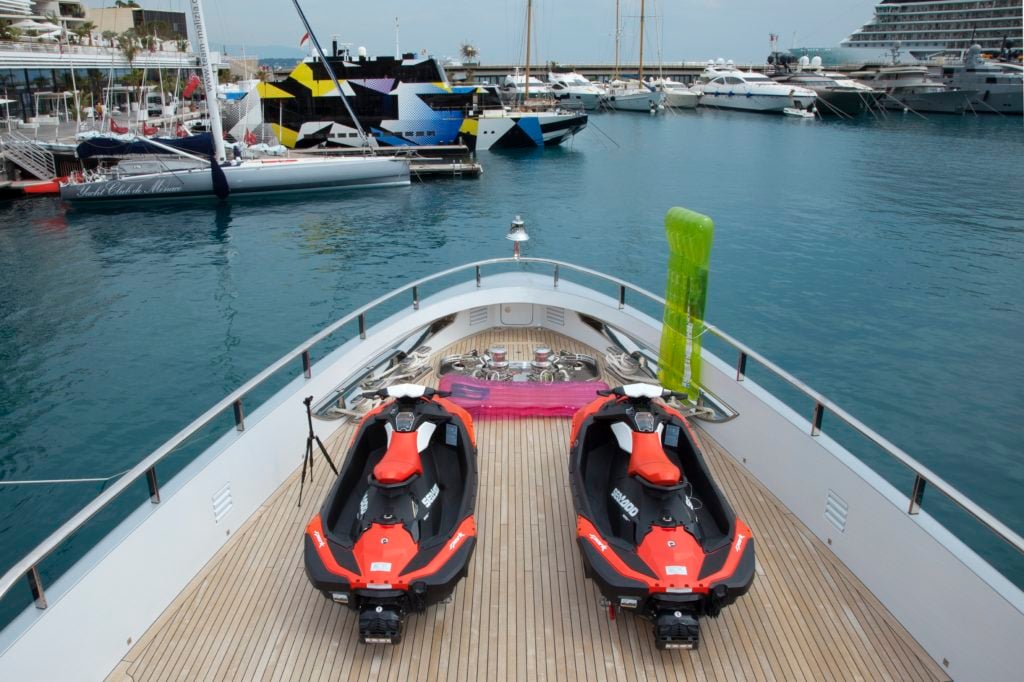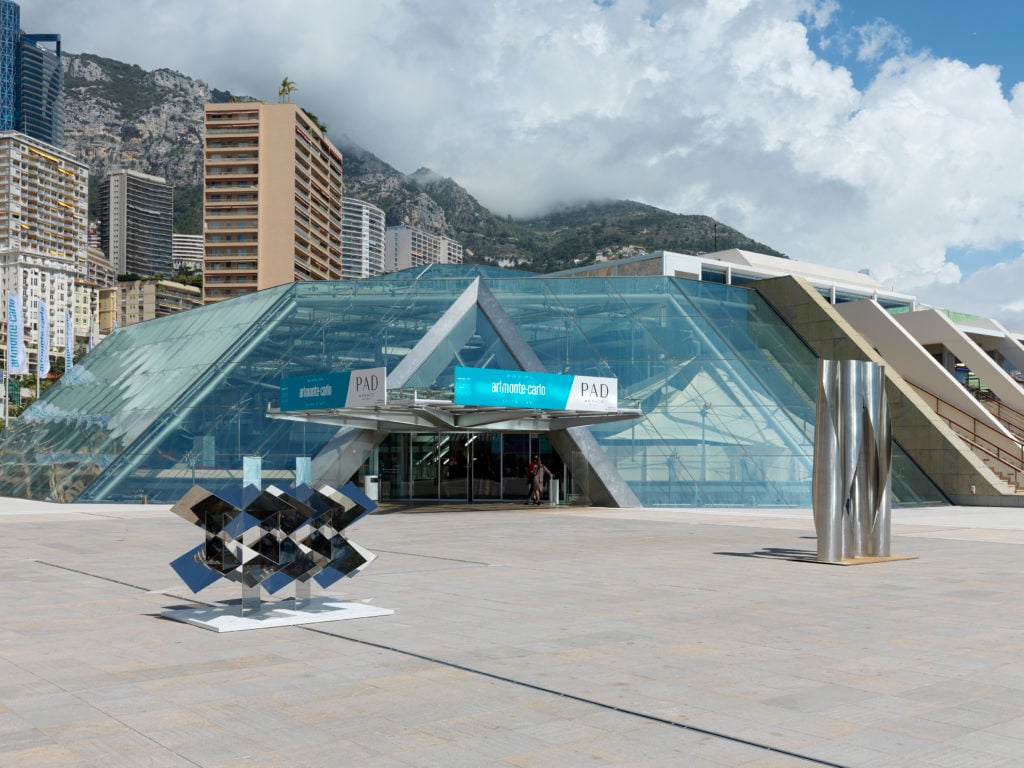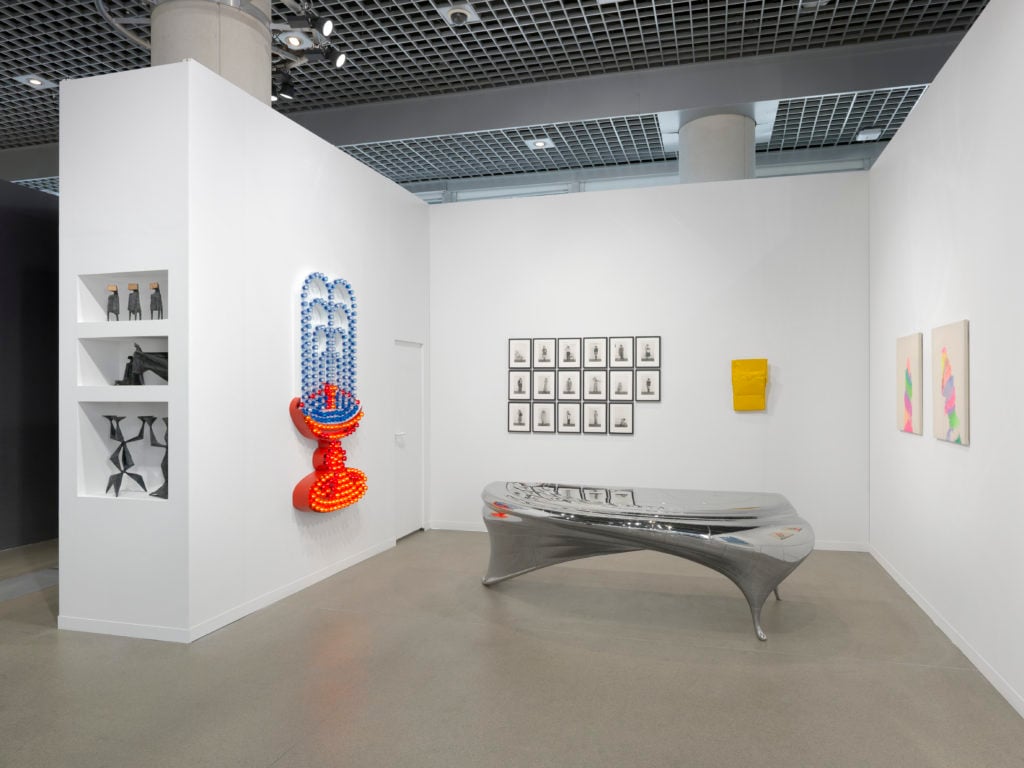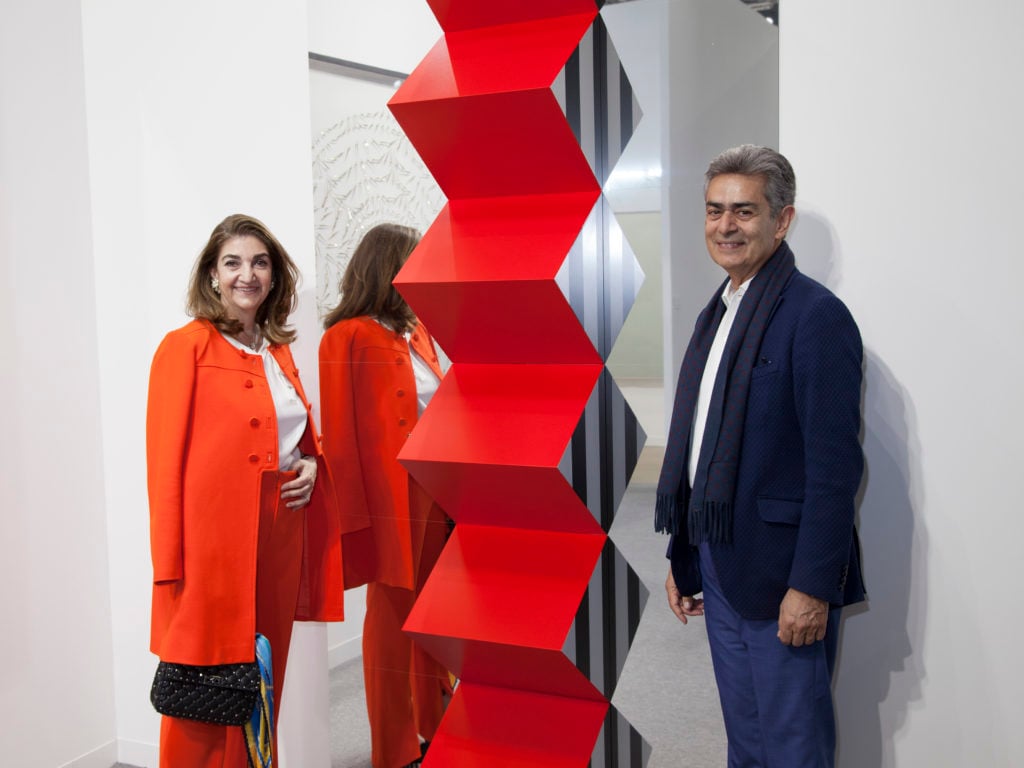Art Fairs
Why the Tiny City-State of Monaco Might Be Home to the World’s Most Resplendent Art Fair
The royal affair, now in its fifth edition, may be the most luxurious art fair in business.
The royal affair, now in its fifth edition, may be the most luxurious art fair in business.
Louisa Elderton

Is artmonte-carlo the world’s fanciest art fair? If the private jets, helicopters, yachts, diamond jewelry, honey-glazed pig’s heads, meringues, velvety cream cakes, and—oh yes—million-dollar artworks are anything to go by, then yes, it is.
Monaco, a miniature, independent city-state cut out of France’s Mediterranean coastline, feels a bit like a 1960s James Bond film. There are high-rise condos and casinos, Porsches zooming through tunnels carved into rock, rising mist, and azure blue skies. The air is thick with car fumes and perfumes, and extravagant sporting events are always in the works, from the Rolex Masters tennis tournament and Grand Prix to the more horsey Polo Cup and Jumping International. This year, artmonte-carlo’s VIP collectors were flown into the principality on private jets from Art Brussels and Berlin Gallery Weekend, all of which coincided in the same week.
“If you propose two days in Brussels, one in Monaco, one in Berlin, it’s super attractive,” artmonte-carlo’s director, Thomas Hug, told artnet News. “You have to be humble. If you really want people from all over the world coming, you have to [offer] a VIP option like this.”

For artmonte-carlo in 2018, Juliette Desorgues curated art on a private boat.
Attending collectors at the event last week included the likes of France-based design patron Silvia Fiorucci-Roman (who even loaned a vast installation by Armenian artist Anna Boghiguian for the fair’s entrance space) and Safia El Malqui, wife of Saudi billionaire businessman Nasser Ibrahim Al-Rashid. Among the local connoisseurs attending the 5th edition of the relatively new art fair was Delphine Pastor, daughter of the prominent Monaco collector and real estate heir Michel Pastor.
The event, which is a sister edition to Art Genève, is also a royal affair. Organized under the patronage of Albert II, Prince of Monaco, artmonte-carlo is also represented by Beatrice Borromeo
(the daughter-in-law to Caroline, Princess of Hanover), one of its official ambassadors.
“I’m not from Monaco, and you need to be accepted in the family [here],” Hug says. “This patronage is very important because we know we are welcome, and the principality will benefit.”
In the Grimaldi Forum, a 377,000-square-foot conference center on the seafront, the number of exhibitors this year nearly doubled from the year prior, from 40 to 75 galleries. Modern and contemporary artworks were shown on the middle floor, with the design fair PAD Monaco—a new collaboration between the two shows—on the ground floor.

Photo: Annik Wetter
A corridor-like section of 10 galleries with solo shows led to PAD, but these exhibitors deserved more space. Much of the innovative work on view there—including Cinzia Ruggeri’s surreal sculptures that often double as furniture, on view through Galleria Federico Vavassori—became lost in the oddly silent thoroughfare.
This kind of hybridity will likely continue to attract local residents, while the top globe-trotters could be swayed also by Monte Carlo’s Freeport status. So do these wealthy collectors have a responsibility to pay their fair share of tax? “The same collectors that use this tool are the same collectors who are paying the most tax,” Hug says. “There is a false idea about the freeport in terms of image.”
Image and money are arguably everything when it comes to Monte Carlo, something that British artist Zoë Williams tried to mirror in her soirée Ruffles, a lively performance at the fair’s vernissage party. It comprised a decadent dinner party of women cavorting in bacchanalian fashion, climbing onto tables, shoving handfuls of cake into their mouths, breasts and bums semi-out, culminating in someone humping a cake like a Hogarthian satire. This sounds like a subversive statement about class, gender, and exploitation. It wasn’t. With observers gleefully watching, it felt nearer to titillating entertainment that stopped before things got too uncouth, uncomfortable, or confrontational: a pseudo-radical gesture that turned the artist into pawn.

Blain|Southern’s booth at artmonte-carlo. Photo: Annik Wetter.
Returning blue-chip names included White Cube, Perrotin, Victoria Miro and Blain|Southern, with Robilant + Voena presenting—alongside the expected Lucio Fontanas—some 1960s candy-colored iron sculptures by the lesser-known Italian artist Pietro Consagra (priced at €28,000). The highlight was his salmon-pink bookshelf, Libreria Fontale, from 1998.
While numerous works by Enrico Castellani, Anish Kapoor, and Damien Hirst dotted many of the booths, setting the general slick tone of the main section, younger artists were also present, including Than Hussein Clark, who presented two towering, majorelle blue plinths with faces illuminated by porcelain light bulbs at Crèvecoeur’s booth. They sold to a local collection on the opening day for €10,000. Their geometric abstract paintings by the Argentinan Ad Minoliti (€20,000) were also playfully anthropomorphic, her interest in Donna Haraway’s “A Cyborg Manifesto” giving her work a animated feminist tilt. (She will be included in this year’s Venice Biennale.)
The generally quiet halls at artmonte-carlo didn’t necessarily bother dealers because they were looking not for the glitterati, but for select (glittery) local collectors. Laurène Maréchal from Switzerland’s Galerie Artvera’s wanted “good people for longer conversations” about their strong booth of Modern paintings, from an exquisite portrait by Kees Van Dongen to Philip Andreevich Maliavin’s Nymphe (ca. 1920–30), an ostensibly abstract canvas of milky limbs sinking into algae-green shallows. Their one contemporary work, by Korean artist Jung Hai Yun, a golden watercolor of equally chattering and lonesome birds (a metaphor for society) sold on the first day for €13,500, so they were satisfied.

Mega collectors Fatima and Eskander Maleki at artmonte-carlo.
And what did gallerists think about this year’s fine art-design hybrid? “Why not?” said Shona van der Merwe from SMAC Gallery in Cape Town, a sentiment that seemed to be shared by everyone. From PAD’s Pre-Columbian treasures at Mermoz gallery’s both (Mexican stone sculptures from 900 BC depicting startled cats and long-beaked birds) to the “wearable art” at Elisabetta Cipriani (24-carat-gold Egyptian hieroglyphic rings by Ai Weiwei and pouting lip versions by Jannis Kounellis), this section was the liveliest, with champagne-sipping matadors (the phrase for local VIPs) throughout.
With a wink to design infiltrating many of the main fair’s booths, the disappearing hierarchy between fine art, craft, and design felt like a clear statement of purpose. And with Monte Carlo’s main business being real estate, its rampant building works expanding the cityscape into the sea, there are many square feet that need all kinds of dressing up. So the market, as ever, turns up.